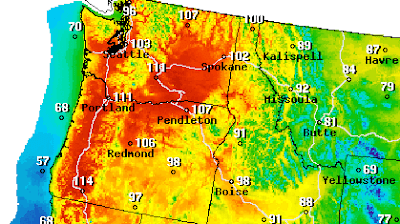NASA’s AIRS Tracks Record-Breaking Heat Wave in Pacific Northwest
The science instrument mapped the dome of high pressure that settled over the northwestern U.S. and western Canada in late June, sending temperatures into the triple digits.
In the Pacific Northwest and western Canada, an extreme heat wave that began on June 26 shattered multiple all-time temperature records. From June 21 to June 30, NASA's Atmospheric Infrared Sounder (AIRS) aboard the Aqua satellite caught the movement of this slow-moving heat dome throughout the region. Surface air temperature anomalies — readings above or below long-term averages – can be shown in an animation of some of the AIRS data. When individuals are outside, they may directly feel the temperature of the surface air.
The highs in several cases broke prior temperature records by several degrees or more. Quillayute, Washington, established an all-time high temperature record of 110 degrees Fahrenheit (43 degrees Celsius) on June 28, eclipsing the previous high of 99 degrees Fahrenheit (37 degrees Celsius). Several meteorological stations set records on consecutive days, demonstrating the unusual nature of this high heat, which is also blamed for several deaths. On June 29, the community of Lytton in British Columbia set a new all-time record for Canada with a temperature of 119 degrees Fahrenheit (48 degrees Celsius), only to break it the next day with a temperature of 121 degrees Fahrenheit. (49 degrees Celsius).
Similar temperature anomalies were detected by the AIRS instrument at an altitude of around 10,000 feet (3,000 metres), indicating that the severe heat had an impact on mountainous areas as well. Temperature anomalies at 18,000 feet (5,500 metres) showed that the heat dome reached high into the troposphere, producing conditions for severe heat at the planet's surface that are not ordinarily present.
AIRS detects emitted infrared and microwave radiation from Earth, working in tandem with the Advanced Microwave Sounding Unit (AMSU), to provide a three-dimensional view of the planet's weather and environment. The two instruments work together to make simultaneous observations at the Earth's surface. The system provides a global, three-dimensional picture of atmospheric temperature and humidity, cloud quantities and heights, greenhouse gas concentrations, and many other meteorological phenomena using more than 2,000 channels monitoring different parts of the atmosphere.The AIRS and AMSU instruments were launched into Earth orbit in 2002 on NASA's Aqua spacecraft and are administered by NASA's Jet Propulsion Laboratory in Southern California under contract. Caltech has a section called JPL.

Post a Comment